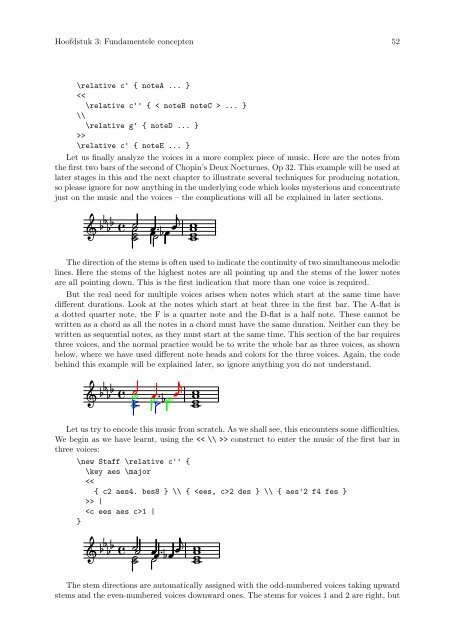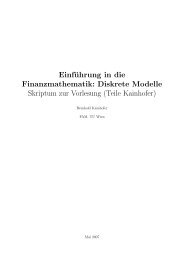LilyPond Beginnershandleiding
LilyPond Beginnershandleiding
LilyPond Beginnershandleiding
Create successful ePaper yourself
Turn your PDF publications into a flip-book with our unique Google optimized e-Paper software.
Hoofdstuk 3: Fundamentele concepten 52<br />
\relative c' { noteA ... }<br />
... }<br />
\\<br />
\relative g' { noteD ... }<br />
>><br />
\relative c' { noteE ... }<br />
Let us finally analyze the voices in a more complex piece of music. Here are the notes from<br />
the first two bars of the second of Chopin’s Deux Nocturnes, Op 32. This example will be used at<br />
later stages in this and the next chapter to illustrate several techniques for producing notation,<br />
so please ignore for now anything in the underlying code which looks mysterious and concentrate<br />
just on the music and the voices – the complications will all be explained in later sections.<br />
<br />
<br />
<br />
<br />
<br />
<br />
<br />
<br />
The direction of the stems is often used to indicate the continuity of two simultaneous melodic<br />
lines. Here the stems of the highest notes are all pointing up and the stems of the lower notes<br />
are all pointing down. This is the first indication that more than one voice is required.<br />
But the real need for multiple voices arises when notes which start at the same time have<br />
different durations. Look at the notes which start at beat three in the first bar. The A-flat is<br />
a dotted quarter note, the F is a quarter note and the D-flat is a half note. These cannot be<br />
written as a chord as all the notes in a chord must have the same duration. Neither can they be<br />
written as sequential notes, as they must start at the same time. This section of the bar requires<br />
three voices, and the normal practice would be to write the whole bar as three voices, as shown<br />
below, where we have used different note heads and colors for the three voices. Again, the code<br />
behind this example will be explained later, so ignore anything you do not understand.<br />
<br />
<br />
<br />
<br />
<br />
<br />
<br />
Let us try to encode this music from scratch. As we shall see, this encounters some difficulties.<br />
We begin as we have learnt, using the > construct to enter the music of the first bar in<br />
three voices:<br />
\new Staff \relative c'' {<br />
\key aes \major<br />



